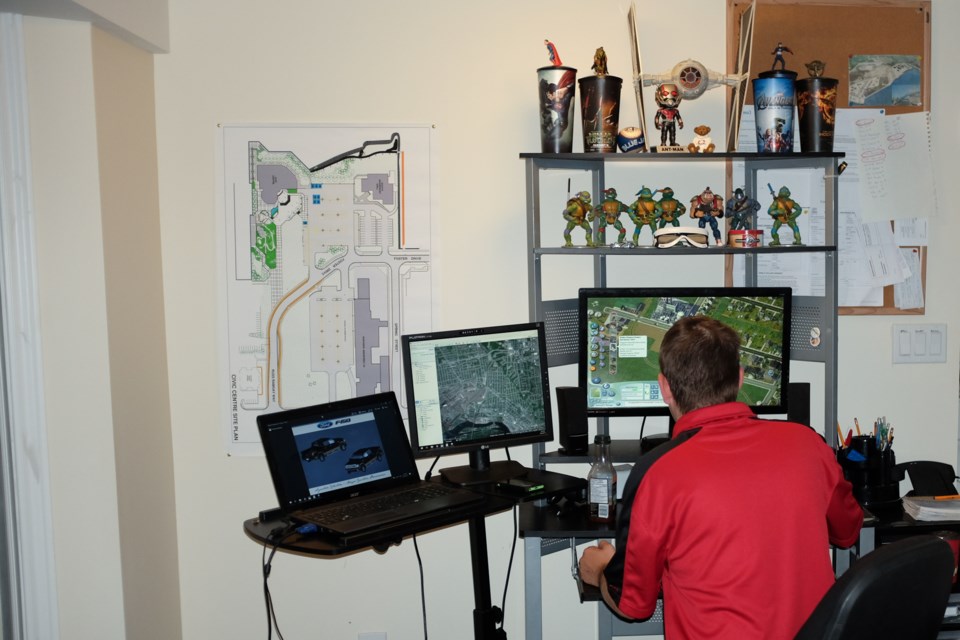Halfway into a 10-year project that relies on 13-year-old software, a group is determined to make an evolving 3D digital model of Sault Ste. Marie.
They're building it within the video game Sim City 4, a city-simulation developed by Maxis back in 2003.
It challenges players to use urban planning and city building skills to build and run a living model of a city.
Project Sault Ste. Marie (PSSM), as the group is called, is modeling the streets, vehicles, buildings, and other properties of the Sault and its surrounding areas inside the game.
When they’re finished, they hope that users can ‘play’ a simulation of the city.
The group started the project five years ago and say they are about halfway done.
That means by the time they’ve completed the project the software will be 18 years old.
“To me, although the software may seem outdated, it’s still fairly useful and it works for us on a day to day basis. You can run it on any windows computer from 2003 to today,” said Derek Pearce, one of the founders of PSSM.
The game has survived every new version of Windows so far, and Pearce is confident it will continue to work well into the future.
“We hope Microsoft doesn’t change anything with Windows that makes it obsolete. If they do, we’ll just cross that bridge when we get to it,” said Pearce, confidently.
In 2013, Maxis released a new version of Sim City, but Pearce said it’s not ideal for his team since it’s only playable online and the map size is limited to 10 square km.
PSSM is currently mapping a 49-square-kilometre area that includes both the Ontario and Michigan Saults as well as the surrounding areas.
Although Sim City 4 is old, Pearce is adamant that there is still a strong community worldwide.
Simtropolis.com, an online community for Sim City users, boasts over 680,000 registered users.
How many of those are active is unclear.
PSSM currently has a 12-member international team that works on the project weekly - six in the Sault, two in England, and one in Sacramento, Detroit, France, and Singapore – and they’ve had 30-40 other people help out here and there throughout the years.
Sim City 4, like other version of the game, realistically mimics how a city’s taxes, roads, zoning, pollution, happiness of residents, and a variety of other metrics, work in real life.
For example, raising property taxes can mean that there is less development, or not enough roads will mean traffic congestion.
A big selling point of the game is that all of this occurs in an eye-pleasing, ever evolving detailed 3D cityscape.
When PSSM is done, that model will look like Sault Ste. Marie with the same geography, street layout, and recognizable local buildings.
The group said they’ve finished tweaking how the simulation will work and now they’re focusing mostly on creating 3D visualizations.
“We’ve come up with the concept, what works, and now we just have to get to the actual simulating,” said Derek Pearce, who started the project five years ago with his childhood friend Adam Pearse.
The group exploits game modifications and software that lets tehm unlock hidden game features.
For example, someone (not in their group) found a way to unlock a feature to make difficult curves in roads which then let PSSM model difficult curves and intersections, like the ‘wedge’ where Gore Street, North Street, Wellington Street, and Cathcart Street meet.
The PSSM team has already modeled Mayor Christian Provenzano’s pickup truck, the Algoma Welcome Arch, city police vehicles, the Wendy’s on Queen Street, the Community First Credit Union, and several other recognizable buildings, vehicles, and landmarks.
PSSM believes the simulation can work as a city map for bus routes and the hub trail, and could be used to promote tourism, but perhaps more interestingly they claim, it can be used to simulate city development.
For example, at a recent meeting Councilor Frank Fata brought up the topic of selling part of Bellevue Park.
Once finished, the game would be able to simulate the rezoning of Bellevue Park and then see what effects that would have on the rest of the city.
“What happens when you remove a park from one area? What will the effects of that be on city residents? How will it affect morale? We could run tests in our simulation,” said Pearce.
Pearce said PSSM will also be able to simulate situations like the steel plant closing down, and hopefully glean understanding of what that something like that would do to the city.
He expects the model will be 50-60 per cent accurate in its predictive ability.
When they’re finished, PSSM will be downloadable to the public..
They also might try to set up publicly accessible computers dedicated to running the simulation at places like the Canadian Bushplane Heritage Centre, public libraries, and city hall.
To raise funds PSSM is taking donations from sponsors and in exchange offering to create 3D models of their businesses to be included in the simulation.
On September 1, PSSM is releasing its first sponsored building via Twitter, The Community First Curling Arena.
With a projected 10 years in total to finish the project, what keeps Pearce going?
“I love this city. It’s the place I grew up. I guess I would say I have strong civic pride,” he said.
